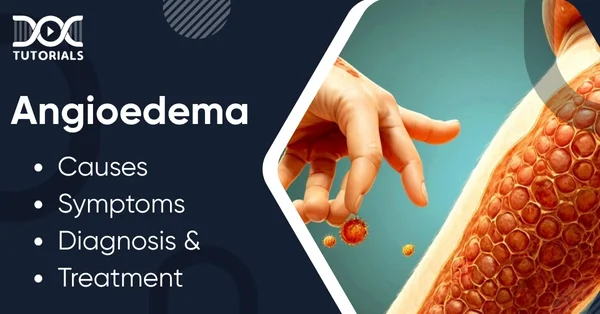Angioedema: Causes, Symptoms, Diagnosis, and Treatment

Angioedema is a skin condition that affects the deep layers of an individual’s skin. It often appears along with hives or may appear independently on an individual’s face. Research shows that it is a common condition affecting almost 10% to 20% of people during their lifetime.
If you are a NEET PG aspirant, detailed knowledge of angioedema is required as it is a vital topic of your syllabus. So, continue reading to learn about the causes, symptoms, diagnosis, and treatment methods of angioedema.
What is Angioedema?
When the dermis (inner layer of the skin) or the layer below the mucous membrane swells up due to a certain trigger, it is called angioedema. The causes for this condition and urticaria are almost similar, so angioedema can occur with hives.
In cases of angioedema or hives, the swelling is caused by liquid that fills the tissues after escaping from small blood vessels. This condition mainly affects an individual’s eyes and lips and lasts for one or two days. However, if it affects an individual’s airways, it can be life-threatening.
What are the Causes of Angioedema?
When allergic reactions occur, they often lead to the release of histamine into the bloodstream, causing angioedema.
Take a look at some more angioedema causes:
- Allergies that are caused by insect bites, foods, scales of the skin that an animal sheds, pollen, etc.
- Heat, sunlight, cold, or water exposure
- NSAIDs (nonsteroidal anti-inflammatory drugs), antibiotics like sulfa drugs and penicillin, ACE inhibitors or other blood pressure drugs
- Lupus, lymphoma, leukaemia, or other autoimmune diseases
- Infection
Hereditary angioedema comes with different complications, triggers, and treatment procedures.
What are the Risk Factors of Angioedema?
Here are some of the factors that increase the risk of angioedema and hives:
- Allergic to certain substances
- If you have suffered from angioedema previously
- Family history of angioedema or hives
What are the Symptoms of Angioedema?
Depending on the type of angioedema, there can be the following symptoms:
- Swelling that may feel slightly burning, painful, and itchy
- Allergic reaction in genitals, limbs, throats, and tongues
- Swelling around the lips and eyes in red colour
- Breathing issues due to angioedema lips and throat swelling during severe cases
- If angioedema affects the intestinal tract, the lining will swell up, causing abdominal cramps
- Dizziness
Angioedema affects the inner part of an individual’s skin without causing any damage to the outer layer.
How to Diagnose Angioedema?
A doctor diagnoses angioedema by carefully examining the symptoms and asking about possible triggers like the following:
- Recent exposure to allergens
- Medications
- Family history of similar swelling episodes
Allergic angioedema is suspected if the swelling follows contact with a known allergen. A family history may point to hereditary angioedema, which is often linked to low or dysfunctional C1 esterase inhibitor (C1-INH) protein.
To confirm the diagnosis and identify the type, further tests may be recommended by your healthcare provider. These include the following:
- Skin Prick Test
It helps check for allergies. This test detects the allergens that cause allergic reactions in the patient’s body, leading to angioedema.
- Blood Tests
It helps measure the immune response to allergens and specific C1-INH levels, and function tests. Low or abnormal C1-INH suggests hereditary or acquired angioedema.
Detailed medical and family histories, combined with these tests, help doctors distinguish between allergic, hereditary, and other forms of angioedema, ensuring accurate diagnosis and appropriate treatment.
What are the Treatment Options for Angioedema?
Angioedema treatment includes the following methods based on the severity of the issue:
- Mild Cases
If symptoms are minor, treatment may not be necessary. Monitoring and avoiding known triggers can be sufficient for mild angioedema.
- Emergency Treatment for Severe Allergic Reactions
For severe allergic reactions with significant swelling or breathing difficulties, immediate administration of epinephrine (EpiPen) is critical to prevent life-threatening complications.
- Antihistamines
Antihistamines such as loratadine and cetirizine are commonly used when the cause of angioedema is unknown or allergy-related. These medications help reduce swelling and itching.
- Glucocorticosteroids
In cases where angioedema is triggered by an allergic response, glucocorticosteroids like prednisone or Solu-Medrol may be prescribed to control inflammation and swelling.
- Treatments for Hereditary Angioedema
Hereditary angioedema may require more specialised interventions, including C1 inhibitors, ecallantide, kallikrein inhibitors, or icatibant, which target the underlying biochemical pathways.
Surgical intervention or intubation may be needed in severe cases if airway obstruction occurs.
- Lifestyle and Natural Remedies
Wearing loose cotton clothing and applying cool, wet compresses can soothe the skin and reduce irritation. Avoiding known triggers and switching medications if a drug is causing symptoms are important preventive steps.
- Long-term Management
For recurrent or chronic angioedema, long-term use of C1 inhibitors may be recommended, especially for hereditary forms. Pregnant individuals should consult their doctor before starting any treatment.
FAQs About Angioedema
- Is it possible to prevent angioedema?
To prevent allergy-related angioedema, avoid foods, medications, or other triggers known to cause your allergic reactions. For non-allergic angioedema caused by ACE inhibitors, you should work with your healthcare provider to find a different medication and never restart the one that caused the reaction.
- What is considered the best treatment for angioedema?
Angioedema treatment depends on the type of allergic reaction. Hereditary angioedema isn’t curable, but allergic and idiopathic angioedema can be managed with antihistamines and corticosteroids.
- Can angioedema cause death?
Allergic angioedema can occasionally become severe and lead to anaphylaxis, a life-threatening allergic reaction that requires immediate emergency medical treatment.
- How to take care of yourself if you have angioedema?
If you experience angioedema, avoid known triggers and follow your doctor’s medication instructions. Always carry your epinephrine injector and teach family and friends how to use it in emergencies.
- What are the complications of angioedema?
A major complication of angioedema is swelling of the tongue or throat, which can make breathing difficult and may rapidly lead to airway obstruction. If the airway becomes blocked, this situation is life-threatening and requires emergency intervention, such as intubation or even surgical airway management, to prevent asphyxiation.
Conclusion
Angioedema usually gets cured on its own, even without any treatment. However, if it occurs on a person’s tongue or throat, it will block the airways. This is a severe condition that requires medical intervention.
Medical students, especially those appearing for NEET PG exams, must acquire a more profound knowledge of this topic. To guide you professionally, DocTutorials has brought advanced teaching techniques, concise video lectures, mock tests, question banks, and more. Join our NEET PG course today for the best guidance!
Latest Blogs
-

NEET PG Exam 2025- Date, Pattern, Marking Scheme, Subject Wise Weightage, and Exam Mode
NEET PG Exam 2025 is the ultimate gateway for medical graduates aspiring to pursue postgraduate courses in medicine, including MD,…
-

INI CET Exam 2025: Your Roadmap to Success – Key Topics, Strategies, and Lessons from Last Year’s Papers
The INI CET exam is more than just a test; it’s a significant milestone for many medical students aiming to…
-

INI CET Exam Success: Previous Year Question Papers & Ultimate Guide – INI CET PYQ
One can feel overwhelmed while preparing for the INI CET (Institute of National Importance Combined Entrance Test). A vast syllabus,…




